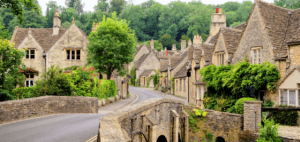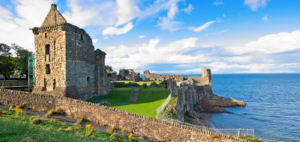Mystras – 10 Impressive Facts, History and More
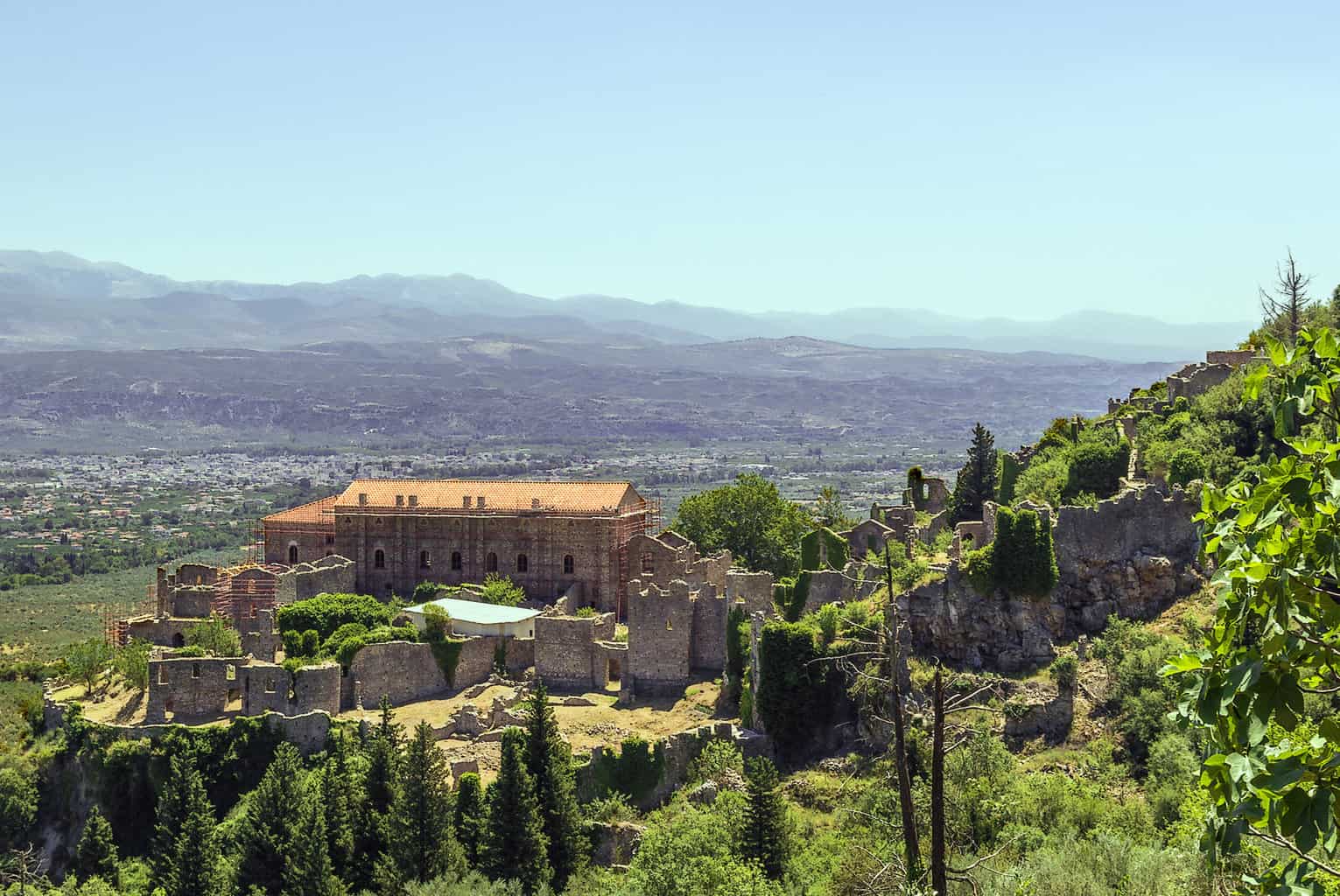
Updated On: November 08, 2023 by Ciaran Connolly
In Greece’s Laconia region of the Peloponnese, there lies a fortified town called Mystras. Located on Mount Taygetos, close to the ancient city of Sparta, it served as the seat of the Byzantine Despotate of Morea in the fourteenth and fifteenth centuries.
The Palaeologan Renaissance, which included the teachings of Gemistos Plethon, brought prosperity and cultural flowering to the region. High-calibre architects and artists were also drawn to the city.
The location was still inhabited during the Ottoman era when it was mistaken for ancient Sparta by Western travellers. It was abandoned in the 1830s, and a new town called Sparti was established about eight kilometres to the east. It now belongs to the Sparti municipality due to the local government reform in 2011.
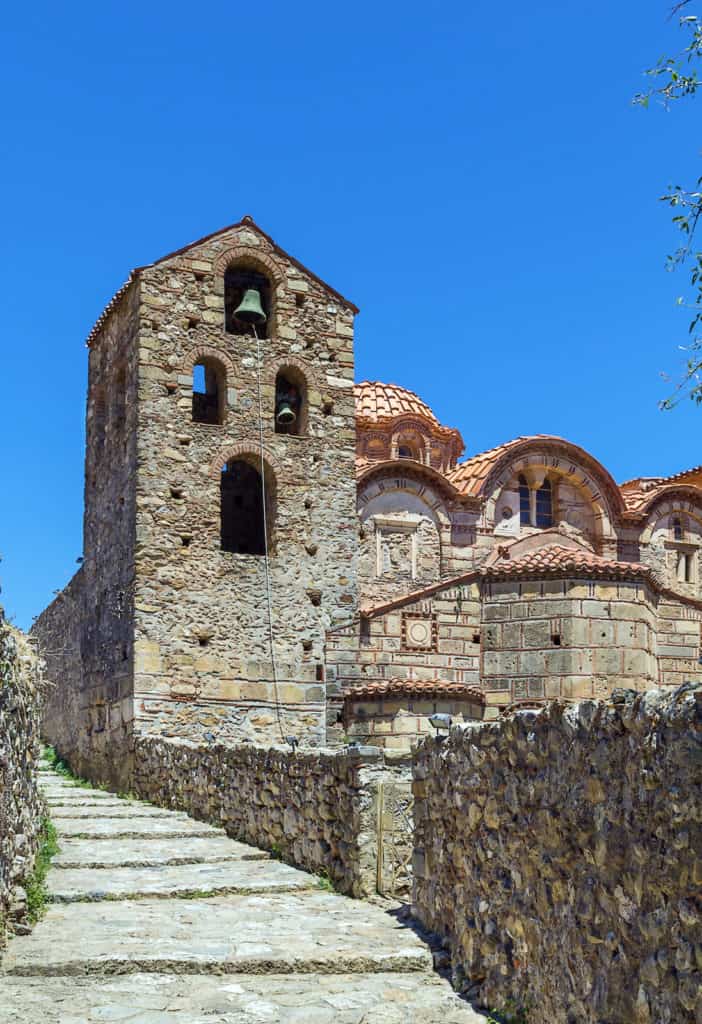
History of Mystras
- Establishment of a City:
William II of Villehardouin, Prince of Achaea (reigned 1246–1278 CE), erected a massive castle atop one of the Taygetus Mountains’ foothills in 1249 CE.
The hill’s original name was Mizithra, but it eventually changed to Mystras. Michael VIII Palaiologos (1259–1282 CE), the emperor of Nicaea (soon to be the emperor of the reconstituted Byzantine Empire after the seizure of Constantinople in 1261 CE), defeated William in the Battle of Pelagonia in 1259 CE, and William was captured.
Mystras Castle became Byzantine in 1262 CE. Mystras was a remote Byzantine outpost in the middle of Frankish Achaean territory when it was initially settled.
The Greek inhabitants of Lacedomonia quickly migrated to Mystras, where they could be treated equally with other residents rather than as social outcasts, as the city was still under Frankish control.
Additionally, the insurgents Milengi and Mystras came to terms with recognising Byzantine rule. The following year, a Byzantine force attempted to retake the surrounding territory but was repelled by the Franks.
An Achaean army even attacked Mystras, but driving out the Byzantine garrison was difficult. Since the Greek population had relocated to Mystras, Lacedemonia was mainly uninhabited at the time and was abandoned after the Franks withdrew.
- Restoration of Byzantium:
Restoration of the Byzantine The Laconian plain as a whole was ruled by the Byzantines throughout the next ten years.
The kings of Naples and the princes of Achaea made threats and engaged in border skirmishes. Still, the Principality of Achaea steadily deteriorated until, by the middle of the fourteenth century CE, it was no longer a significant danger to the Byzantine territories in the Peloponnese.
Mystras was the provincial capital from this point on, but it was not until the first tyrant was selected to administer the Morea in 1349 CE that it became the kingdom’s capital.
Although Mystras and the surrounding province were still firmly under Byzantine rule, Manuel essentially ruled an area on his own, following his policies and taking over his father’s administration because of the distance to Constantinople.
The Morea capital city, Mystras, benefited from this prosperity and expanded to become a major metropolis. The younger sons of the ruling Byzantine dynasty of Palaiologos—Theodore I, Theodore II, Constantine, and lastly, Thomas and Demetrios—ruled as despots after Manuel, followed by his brother Matthew Kantakouzenos.
They hoped the Hexamilion wall would keep the Ottoman Turks at bay while allowing the Morea to prosper and preserve Byzantine culture under Mystras’ direction. This optimism quickly turned out to be unfounded. In 1395 and 1396 CE invasions, the Ottomans managed to breach the wall.
In 1423 CE, the raid reached Mystras proper. The Despotate of the Morea was divided between two or three despots in its closing decades. Mystras maintained its dominance in the Morea, notwithstanding this agreement.
The last Byzantine emperor, Constantine XI Palaiologos (1449–1453), a former Morean despot, was, installed at Mystras rather than Constantinople, his predecessors. This would be the mountain city’s last celebration before being defeated by the Ottoman Empire in 1460 CE.
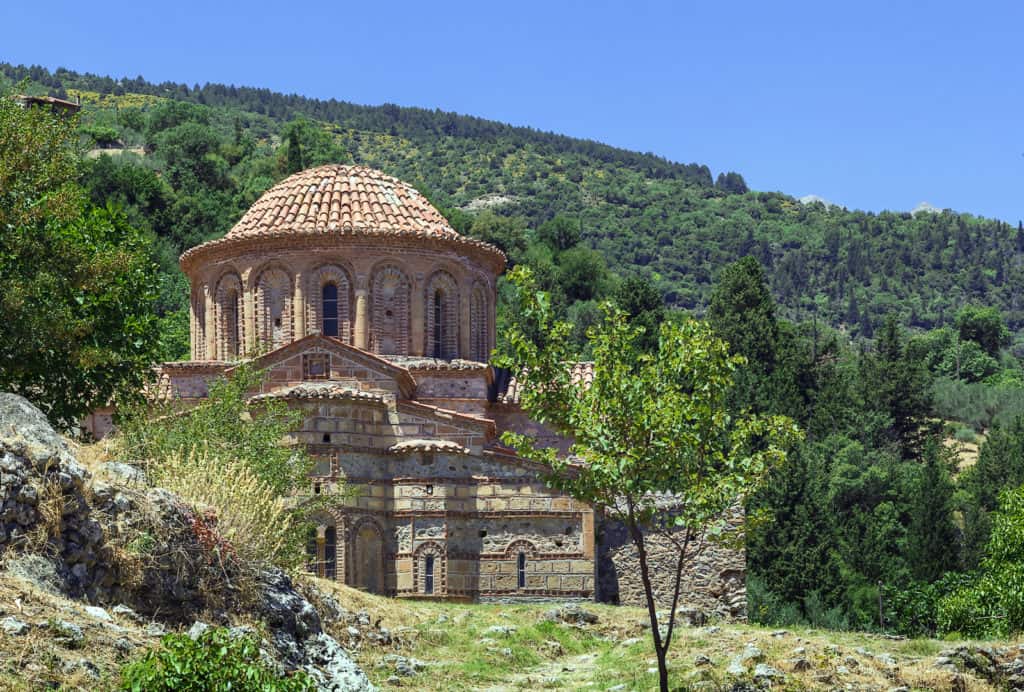
- The Town:
Mystras was a busy city with 20,000 residents at its peak. The city’s three distinct sections were upper, middle and lower towns. The castle of Villehardouin and the palace of the despots were both located in the upper city.
Only the castle had been constructed during Villehardouin’s reign. Hence the Byzantines would be responsible for the majority of the building. The only exception was a beautiful Frankish home, which most likely functioned as the castellan’s home.
Manuel Kantakouzenos and the Palaeologan despots would expand onto this home to turn it into the palace of the despots. The most significant renovation featured a throne room that most likely occurred during one of Manuel II’s trips in 1408 or 1415 CE.
Due to the hill city’s constrained area, local magnates built homes there, but there was no distinct aristocratic district with the wealthy and poor’s residences next to one another.
Due to the city’s constrained size, all plazas save for the one in front of the despots’ palace, which took up the most incredible flat surface on the hills, were nonexistent. Even the court of the despots itself resembles modern Italian palazzos rather than the courts of Constantinople.
The homes’ architecture, including the despots’ palace, extensively drew inspiration from Italian influences. Mystras was famous for its churches, which were still constructed in the Byzantine style of overlapping bricks with lines of red brick lending a distinctive accent, complete with barreled ceilings and lovely murals, except for the odd belfry added.
- A learning centre:
The Greek-speaking region saw a cultural revival despite its decline and majority submission to Ottoman and Venetian administrations.
The development of intellectualism in Mystras was aided by frequent visits from the former emperor John VI Kantakouzenos (1347–1354 CE), one of his generation’s foremost historians and thinkers, as well as lively discussions between intellectuals in Constantinople and those who were beginning to settle in Mystras.
The support and encouragement of the despots also enhanced the educational environment. George Gemistos Plethon, a preeminent philosopher of his day who was well knowledgeable about Aristotle and Plato, was the most well-known philosopher to have lived in Mystras.
Around 1407 CE, Plethon was persuaded to go to Mystras, where he could more freely express his thoughts under the patronage of the Palaiologan despots because he found Constantinople too dangerous to raise Neo-Platonism due to the influence of the Orthodox Church.
Additionally, Plethon advanced Greek perspectives on Hellenism. In the last several decades of the Byzantine Empire, the name “Hellene,” which had been reviled for ages as meaning “pagan,” was recovered to designate Greeks.
While a Roman identity was still dominant, the idea of Hellenism gained considerable currency among Byzantine intellectuals. John Eugenics, who studied with Plethon, Isidore of Kyiv, Bessarion of Trebizond, and other prominent Greek scholars of the time, also visited Mystras.
Plethon’s body was taken as the best thing Mystras had to offer by the commander of the Venetian army that briefly overran Mystras in 1465 CE before being forced to flee.
- Following the Ottomans:
The Ottomans established two sanjaks in the Morea when the Despotate of the Morea ended. One of them had Mystras as its capital, and the Turkish pasha ruled from there in a palace of despots.
But in 1687 CE, Mystras and other Southern Greek cities were taken by the Venetians led by Francesco Morosini. Until the Ottomans drove them out in 1715 CE, the Venetians ruled Mystras. During the Orlov Revolt in 1770 CE, Russian-backed Greek uprisings captured Mystras.
The Russians made their way to the coast as the Turkish force approached. The city was ruthlessly pillaged and destroyed. It partially recovered before being torched by Ibrahim Pasha’s Egyptian-Ottoman army in 1824 CE, during the Greek War of Independence.
There was no chance of rebuilding the city since it was so damaged. Otto, the Greek monarch (1832–1862), chose to refound the ancient town of Sparta nearby in 1834 CE after creating the new Greek kingdom in 1832 CE. Mystras, the previous capital of the Byzantine Morea, would now only be the city of despots’ ruins.
- Nowadays:
Mystras’ ruins are still visible today. A museum and the partially reconstructed city remains of Mystras may be seen at this UNESCO World Heritage Site.
The Pantanassa Monastery’s nuns are the only people in the area today. However, the citadel of Villehardouin and the city walls’ remnants still protrude over the surrounding plain.
Most significant churches, including St. Demetrios, the Hagia Sophia, St. George, and the Monastery of Peribleptos, are still intact. The palace of the despots, a well-known attraction, has undergone significant restorations in the previous ten years.
Visitors can explore the ruins, which are not far from the modern city of Sparti and not far from Mystras. Mystras is one of the most well-known historical monuments in Greece today. Yet, it offers a serene and unsettling journey back into the declining Byzantine Empire and the brief renaissance that Mystras enjoyed.
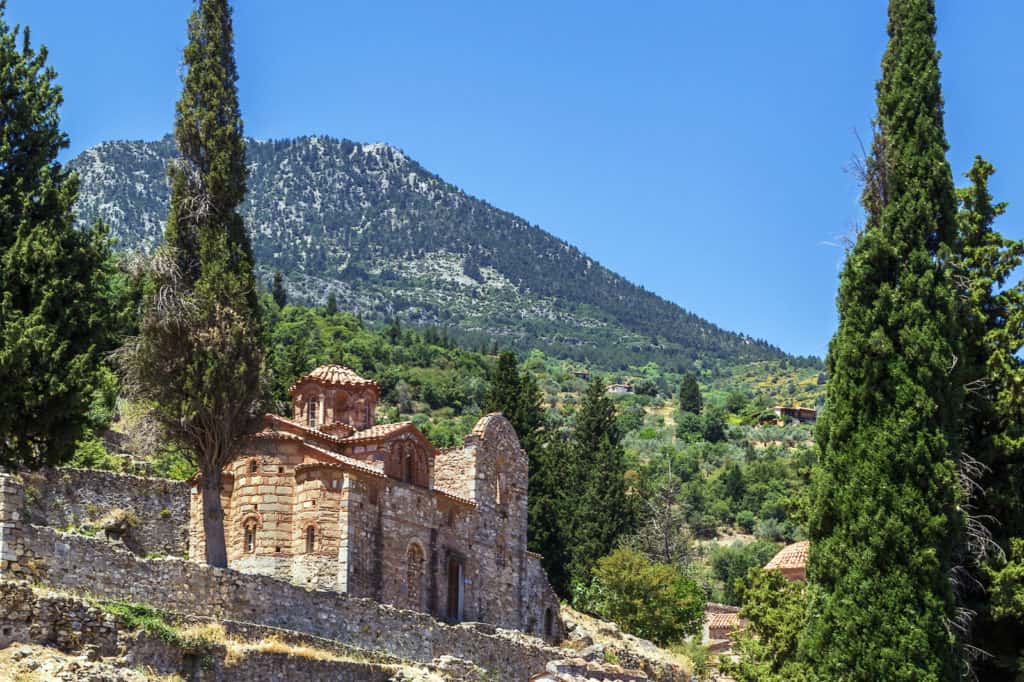
Mystras Weather
Because of its predominantly continental climate, Mystras occasionally experiences abrupt weather changes. The summer months, when temperatures reach 35 to 40 degrees Celsius, are the hottest, from late April to early October.
To explore the rugged region of ancient Mystras, you should pack a cap, water bottles, and comfortable walking shoes. The following months, from mid-October through March, have the most rainfall.
Therefore, it would be an excellent idea to bring some rain gear with you; even if you visit the region in the summer, you are urged to do so just in case. The winter months of Mystras may be pretty chilly, even below freezing, and Mount Taygetos is typically covered in snow during this time of year.
Consider this straightforward advice as you decide when to explore the historical artefacts.
Mystras Geography
On the slopes of Taygetos Mountain stands the abandoned Byzantine fortress, Mystras, which has a fascinating history. The ancient site, surrounded by lush vegetation and along the slopes of a steep mountainside, towers dramatically over the present-day settlement of Mystras.
The pine and cypress trees that make up the surrounding vegetation are found around Mystras. The area is ideal for trekking because it has a few small rivers and lakes.
The Byzantine Fortress of Mystras was the second-most significant city in the Byzantine Empire after Constantinople and was built in the 13th century. The old town, which had several churches, homes, and a beautiful Palace of Despots on top of the mountain, was encircled by sturdy walls.
Visitors may obtain that location’s most beautiful view of the Valley of Sparta. Mystras’ topography is relatively untamed and rugged, and mediaeval Venetian artefacts adorn it. Several little, traditional settlements around Mystras have a limited population.
Only a handful of them—Pikoulianika, Magoula, and Trypi—offer a comprehensive view of Greek rural life. Notably, there is a cavern in Trypi that is significant historically. It is the Ceadas Cave, where, according to legend, the Spartans of antiquity would cast their weak infants.
Mystras Architecture
Mystras is the best-preserved castle town in Greece and was a thriving political, military, and cultural hub during the Byzantine era. It incorporates several inspirations from both western culture and Greek tradition.
The architecture of Mystras is exceptional since it formerly served as the post-Byzantine era’s political, military, and cultural hub. The mediaeval city’s distinctive architecture, artwork, and wall frescoes, which may be seen in the remaining monuments, buildings, and churches, provide a lovely trip back in time.
You may see the remains of a wall and an old theatre on the Acropolis site. The mediaeval city of Mystras is brought back to life by a superb mix of remaining castles, monasteries, and palaces.
The Franks constructed the fortification at the hill’s summit, while the Greeks and Turks added additional features afterwards. It has square-shaped towers, three enormous gates, and two walls.
The abandoned palaces of Mystras from the 13th and 14th centuries are composed of several chambers, arches, and attics and are built on rocks. The castle is surrounded by lovely homes, including the well-known Laskaris and Frangopoulos houses.
The wall frescoes of the Byzantine churches in Mystras, including the Cathedral of Agios Demetrios, the church of Hagia Sophia, the monastery of Our Lady Pantanassa, and the church of Our Lady Hodegetria, are outstanding examples of the old surviving churches.
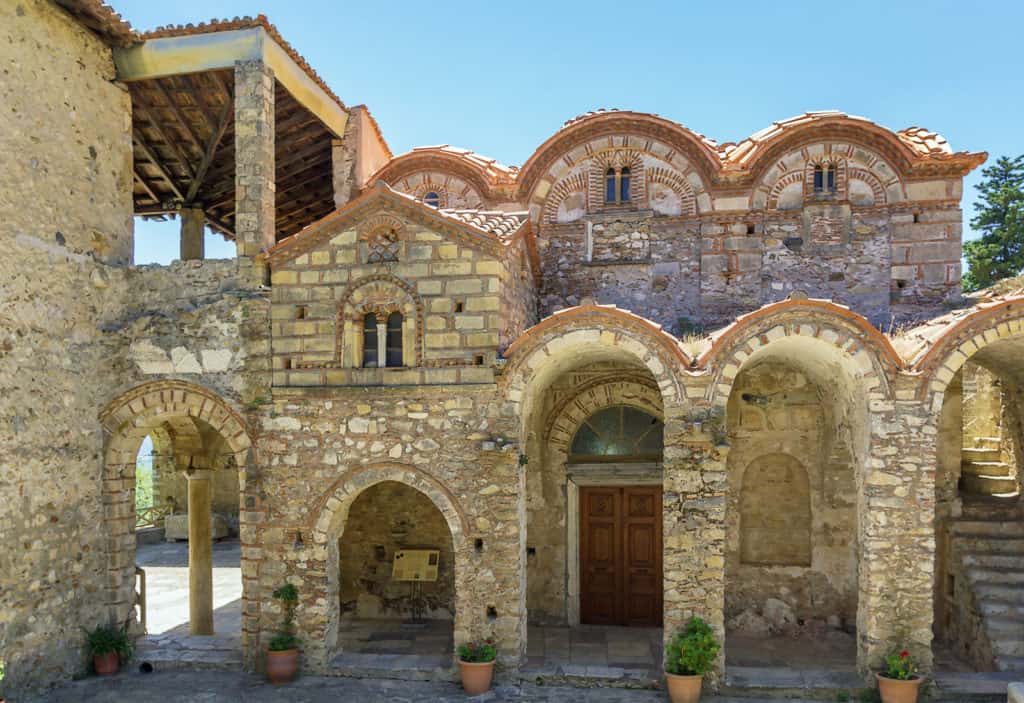
Museums in Mystras
The Byzantine town of Mystras is regarded as a living museum with its extensive collection of artefacts and historical landmarks. The stunning Mystras Museum is located in the church’s courtyard. The two-story structure provides an outstanding tour of its superb finds.
The collection includes artwork, books, jewellery, costumes, and unique clothes. Religious relics also expand the history museum’s extensive collection of exhibits from the Byzantine era. Finally, you can end this fantastic tour with a stroll into the surrounding area.
In addition to the permanent display, two parts of the museum are home to the Pantanassa Church’s iconostases and the wealthy Katakouzinos family, one of Mystras’ most prominent families.
- Mystras Archaeological Museum:
The Agios Demetrios Cathedral’s courtyard is where you’ll find the Archaeological Museum of Mystras. It is located in a two-story structure from which guests may enjoy breathtaking views of the neighbourhood. In 1952, the museum was founded.
Despite being called an archaeological museum, most of the collection’s items are from the Byzantine period. It consists of sculptures, transportable post-Byzantine icons, pieces of murals, and minor objects like jewellery and coins.
Mystras Festivals & Cultural Events
Visitors may enjoy the rebirth of traditions and various activities at the peninsula of Laconia’s several annual festivals. The atmosphere is relatively active, and Mystras, in particular, draws hundreds of tourists.
- Paleologia Festival:
A significant celebration called Paleologia is held in Mystras on 29 May, the anniversary of the Ottomans’ capture of Constantinople in 1453.
This festival honours the dynasty of Byzantine monarchs known as the Palaeologus, and it features an open speech in honour of the last Byzantine emperor, Constantinos Paleologos, a tyrant of Mystras. They died in 1453 while defending Constantinople.
- Sainopoulio Festival:
The Sainopoulio Festival is held in a theatre halfway between Sparti and Mystras. This festival, which features theatrical productions, musical concerts, and other cultural activities, is held each summer in the Sainopoulio Theatre.
- Trade Market:
Mystras has a trade market with regional goods from 27 August to 2 September. One of the oldest fairs in the Peloponnese, this event has a long history and a lot of popularity.
Mystras Nightlife
In Mystras, there are no nightclubs or bars. There are only a few traditional bars in the town square of this little rural community. Try some tasty wine and regional cuisine.
You may go ten minutes to the nearby town of Sparti for bars, but you will only find a few cafe bars there on Kleomvrotou’s paved street and central plaza.
Best Mystras Restaurants:
- Mystras Chromata in Pikoulianika:
Chromata restaurant, which opened in December 2008 and revived a venerable traditional tavern from 1936, has completely changed the landscape of Mystras.
Chromata was renovated by a renowned theatrical scenic artist and is now housed in Pikoulianika, in a typical stone-built villa with stunning views over the entire Byzantine estate.
- Mystras Palaiologos in Town:
Before attempting the ascent to the stronghold, treat yourself to a delectable Greek dinner at the Palaiologos Tavern. This lovely establishment, located in the town’s heart, blends classic features with a homey environment.
Choose between relaxing on the plush couches inside or outside this tavern’s charming yard with its magnificent trees and flowers. You may discover primarily Greek cuisine in Palaiologos, such as souvlaki, tzatziki, and Greek salad.
- Mystras Tavern Pikoulianika in Pikoulianika:
The Pikoulianika tavern opens up in one of Mystras’ most attractive settlements.
The most significant Greek and Mediterranean cuisine, appropriate for even the most discerning palates, is ready for visitors to enjoy in this welcoming and inviting setting, from the most magnificent meat or seafood platters to the most exquisite salads and appetisers.
- Mystras Ktima Skreka in Pikoulianika:
Coffee and food are available starting at noon, although in a different area.
Classic cuisine with a modern touch offers nibbles with every beverage and mood, including raki, ouzo, wine, and beer. All dishes are prepared with fresh, virgin olive oil from the Laconian region.
- Mystras Veil in Pikoulianika:
The Veil Bistrot, whose best feature is an excellent view, has become a typical hangout for locals and visitors in the visually striking Pikoulianika town. It is housed in a simple two-story stone building and serves homemade pastries, cool drinks, and delicious cold platters.
The morning cup of coffee is also available there. Additionally, various beverages and cocktails are open till late at night. The colourful patio is highlighted, perfect for those who love the sun.
Mystras Hotels
- Mystras Inn:
The traditionally constructed Mystras Inn has a restaurant situated in picturesque Mystras Town at the foot of Mount Taygetos. It provides air-conditioned rooms with a balcony or patio and complimentary WiFi.
The rooms feature stone walls and wrought-iron beds, looking out over the mountain, the neighbourhood, or the courtyard.
Each morning, a continental breakfast is available to guests in the dining room or the garden. For lunch or dinner, the restaurant also serves traditional fare. The Takis Aivalis camera museum, which has the most outstanding collection of cameras in the world, is only 100 m from Mystras Inn.
Mystras’s archaeological museum is located one kilometre distant. The distance between Kalamata and Sparti Town is 54 km and 4 km, respectively. On-site private parking is available at no charge and car rental services.
- Archontiko:
Anavriti Village’s centre, at an elevation of 900 metres, is home to the historic Archontiko, which was constructed in 1932. It provides classically furnished apartments with balconies that look out into the neighbourhood.
All the apartments at Archontiko include dark wood furniture, parquet floors and a safety deposit box.
Within 500 metres of the property is a café. Mystras is 14 km distant, while Sparta Town is 15 kilometres away. The distance to Kalamata Airport is 31 kilometres.
- Kyniska Palace Conference & Spa:
Mystras’ Kyniska Palace Conference & Spa is 6 km away from Mystras and offers lodging with a restaurant, free on-site parking, a seasonally open outdoor pool, and a fitness centre.
Each room shows a view of the garden, and visitors have an entrance to a bar and a garden. The lodging supplies a 24-hour front desk, airport shuttles, room service, and free WiFi.
Some of the accommodations at Kyniska Palace Conference & Spa have mountain views and balconies. As well, there are towels and bed linens in every hotel room. A continental or American breakfast is available at Kyniska Palace Conference & Spa. Also, there is a sun deck in the hotel.
Kyniska Palace Conference & Spa is 69 kilometres from Kalamata Captain Vassilis Constantakopoulos Airport, the closest airport.
- Byzantion Hotel:
A short distance from the Archaeological Site lies Hotel Byzantion, which is situated close to the Byzantine village of Mistras. It has accommodations with breathtaking views of Mount Taygetos and historic Mistras.
The luxurious accommodations include balconies with views of the Laconian lowlands. Also, each air-conditioned room has a minibar, satellite TV, and internet connection. The Byzantion Hotel has a pool surrounded by gorgeous landscaping and well-kept grounds.
The sophisticated bar serves beverages and coffee to visitors. The Hotel Byzantion is a great home base for those who appreciate the outdoors. There are lovely trails all around the place. At the front desk, bicycles are available for rent.
On-site private parking is available at no charge. In comparison, it takes 1 hour and 45 minutes to get to Olympia’s ancient site from the beach town of Kalamata.
- Mazaraki Guesthouse:
The traditionally constructed Guesthouse Mazaraki is 600 metres above sea level and adjacent to the lovely hamlet of Mystras. It offers views of the Byzantine fortress of Mystras, the city of Sparta, or the western slopes of Mount Taygetos.
An outdoor pool is available, and the ground floor has a wine bar called “Corfes” with a selection of Greek and regional wine labels. Additionally offered are a library and board games. There is an electric car charging point at the inn.
Four separate buildings make up the Mazaraki Guesthouse, which offers double rooms and suites with either one or two bedrooms. All of the units have a distinct design and carefully picked furniture, and they all have balconies.
Free WiFi and flat-screen TVs are provided. In most cases, a living room with a fireplace is outfitted. Free DVDs, wood for the fireplace, and details on the area’s best dining and nightlife may all be sent.
Every day, a breakfast basket is served that includes handmade pies, jams, fresh eggs, oranges, and toast. On request and at an additional fee, homemade meals cooked using regional ingredients are available.
The Mazaraki Guesthouse is situated in a forested location with several mountain streams and springs. Rentable electric bikes are available. Mystras is 4 km away, Sparta is 9 km away, and the Byzantine Castle is 1 mile away from it.
- Christina Guest House:
In Mystras, about 30 metres from the main square, lies the Christina Guest House, which is surrounded by vegetation. It provides air-conditioned lodging, some of which have balconies with mountain views. Within one kilometre is Mystras’ renowned castle.
All of the rooms at Christina Guest House are simply furnished with dark-coloured hardwood furniture and come with a TV and heating.
A kitchenette and a separate bedroom are features of some apartments. A post office is 40 metres away, and the Photo Equipment Museum is about 100 metres away. On-site, unrestricted private parking is available.
- Mystras Grand Palace Resort & Spa:
The Mystras Grand Palace Resort & Spa has an outdoor pool that is open seasonally and complimentary bicycles. The five-star hotel offers complimentary WiFi, private bathrooms, and air-conditioned rooms.
The hotel has a restaurant, and Mystras is only 11 minutes on foot. At the hotel, a patio is available in each room. All rooms have a flat-screen TV, and most of them have mountain views. There is a sitting space in each of the rooms.
The breakfast section offers a morning buffet. You can enjoy a hot tub, a and a fitness centre are on the premises. One of the things visitors may do close to Mystras Grand Palace Resort & Spa is a hike.
The reception staff would be delighted to provide visitors with directions to the area in German, English, and Russian. Sixty-six kilometres separate you from Kalamata Airport.
Mystras Sights & Attractions
One of Greece’s most well-known ancient sites, Mystras, has been designated a World Heritage Site. In the 13th century, Mystras was a significant Byzantine settlement.
The current town of Sparta was established in the early 19th century, while Mystras progressively decayed and vanished. Including some restored Byzantine churches, it is a significant archaeological site today.
On top of the hill lies a Palace of the Despots and an Archaeological Museum. Mystras includes picturesque towns and hiking trails.
- Mystras Despots Palace:
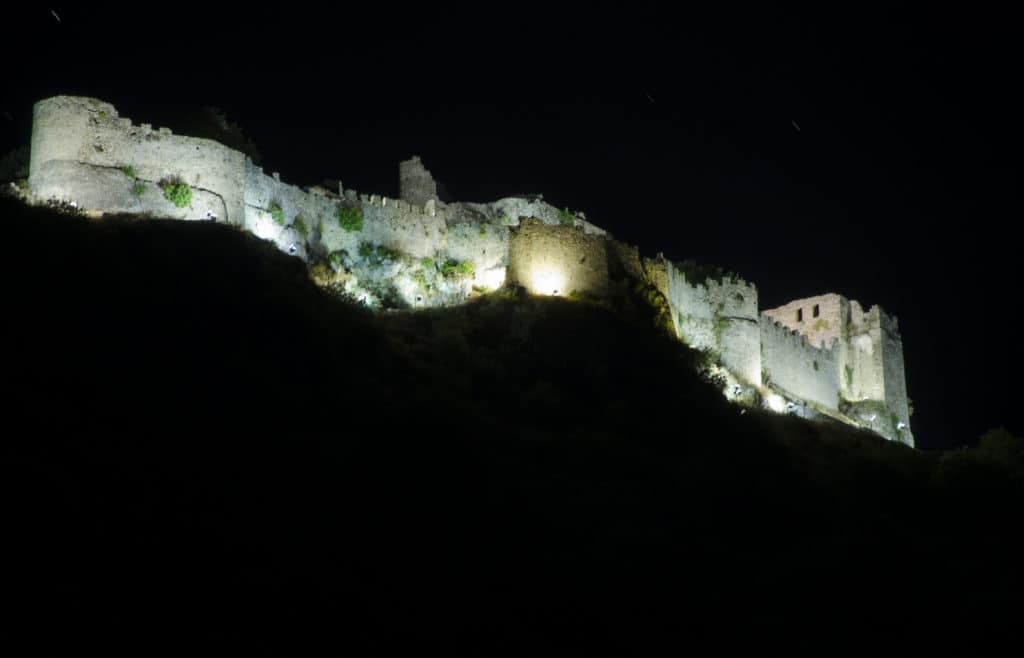
The Upper Town of Mystra is dominated by the Palace of the Despots. It is a sizable collection of structures from various construction eras. The Byzantines finished what the Franks had begun, presumably under the direction of Guillaume de Villehardouin.
The palace of the Despots, typically the emperor’s second son, is situated on a level plateau with a view of the Evrotas valley. These palaces serve as a superb illustration of Byzantine design.
The entire L-shaped building complex has been in good condition up to this point. There are four buildings in the palace. Some are mansions with four stories, while others only have two.
The noblemen’s homes were in the first structure, while the royal hall was in the second. The fourth building, a four-story structure built around 1350–1400 A.D., once housed the Despot. The Paleologos family’s palace was the fifth structure, constructed in the fifteenth century.
Every building has several chambers, attics, cellars, and arches. The area outside is sterile. However, it offers a great perspective of the Spartan plain.
In contrast to the enormous palace of Constantinople, the castle of the Despots is sometimes referred to as the Palataki mansion, which means the small court. It is located on the hill’s summit, above Agios Nikolas Church.
- Cathedral of Agios Demetrios:
The Cathedral of Agios Demetrios, established in 1292 AD, is one of Mystras’ most significant churches. A cross-in-square church was erected on the upper floor of this church in the first half of the 15th century.
The church’s ground floor consists of a three-aisled basilica with a narthex and a bell tower built in the 13th century. Many various types of wall paintings are used to embellish its interior. Constantinos Paleologos, the final Byzantine emperor, was installed here in 1449.
- Mystras Church of Agioi Theodoroi:
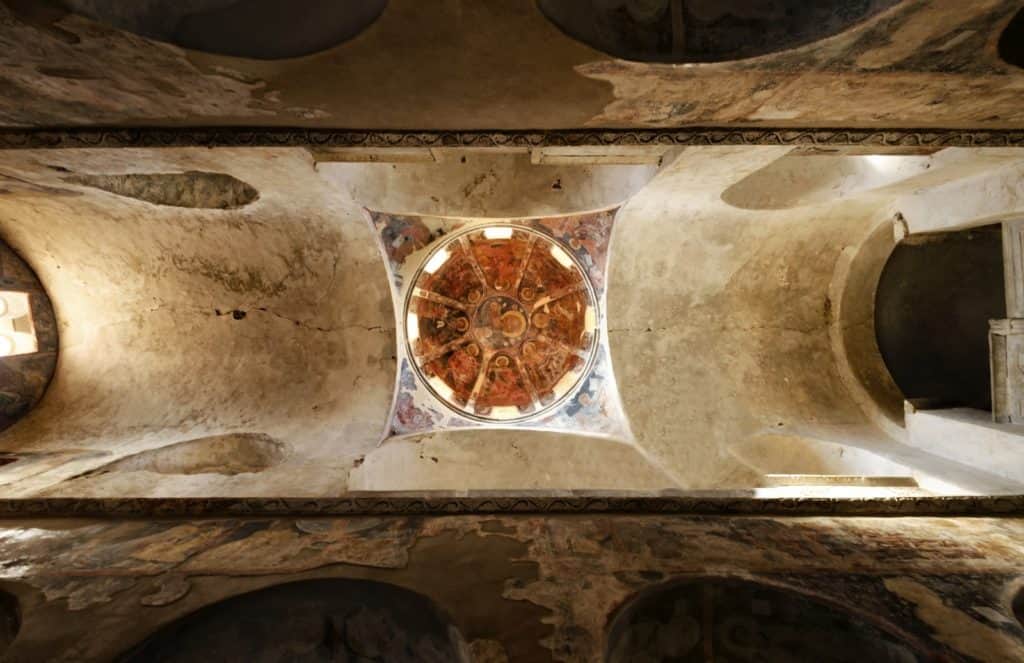
In Mystras, the Church of Agioi Theodoroi is the most significant and oldest chapel. The lowest area of Mystras Old Town, Kato Hora, is where it is situated. Between 1290 and 1295, the monks Daniel and Pahomios built the church.
It was once the catholicon of a monastery before changing its use to become a graveyard church. The church’s architecture is distinctive from that of the Byzantine style and is similar to, but in a more advanced form, the Monastery of Osios Loukas in Distomo Boetia.
The dome is quite spectacular, and the construction progressively points up. The church’s interior is notable for its stunning murals from the 13th century, including portraits of Emperor Manuel Paleologos. Theodore I, the Despot of the Peloponnese, is buried at this chapel.
- Mystras Keadas Cavern:
10 kilometres northwest of Sparta, just outside the town of Trypi, lies a steep valley known as Ceadas. It provides a panoramic view over the Spartan valley and is located at an elevation of 750 metres on the eastern flank of Mount Taygetos.
The historian Plutarch claims that the Spartans of antiquity would cast their sickly and malformed newborns into this cave.
These infants were dumped in that ravine after birth since the community could not employ them and could not develop into robust, powerful soldiers who would have represented the ideal Spartan male type.
Contrary to this custom, archaeological investigation has only uncovered the bones of healthy adults between the ages of 18 and 35, not those of small children.
These men are said to have been criminals who received a death sentence at Caldas and traitors or war captives housed there. Due to nearby rock falling, the cavern is now accessible.
But if you approach, you’ll notice a frigid air emanating from the cavern. According to the ancient Greeks, the souls of the young children who perished there were carried by this breeze.
Shopping in Mystras
- Porfyra Icons in Mystras, Town:
The Porfyra Icons shop in New Mystras, next to the castle, offers the chance to see a long-standing custom. A studio filled with icons made traditionally, with the proper technique and respect for tradition.
Discover the realm of hagiography and observe how a traditional icon is made. Icons are always available on display, but orders for specific icons are also welcome. The shop also sells many handcrafted trinkets, presents, and jewellery in addition to local maps and Mystras history books.
Summary
Geographically, the Byzantine Castle of Mystras is situated close to Sparti Town on the southern side of the Peloponnese. The Castle is a historic city with Byzantine walls and a magnificent palace perched atop a hill.
This location is most well-known for its Byzantine churches and their stunning interior frescoes. The contemporary village of Mystras, which has classic architecture and lovely squares, is located at the base of the hill.
Vacations in Mystras can be paired with excursions to charming nearby places like Monemvasia and Gythio. Several churches and the Palace of Mystras are now being renovated.
You can visit the Archaeological Museum with its extensive collection of Byzantine and religious artefacts in the courtyard of Agios Demetrios. It was considered a UNESCO World Heritage Monument in 1989. Cycling and hiking are among the things to do in the area.



